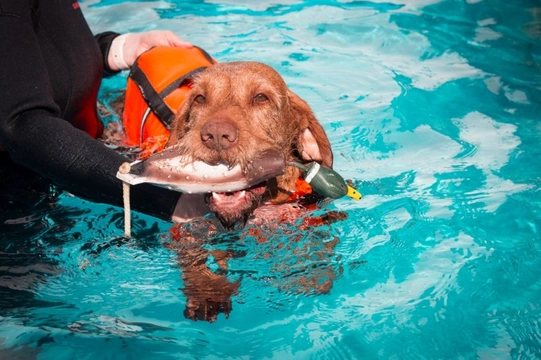
Five frequently asked questions about hydrotherapy for dogs
Hydrotherapy or water therapy is something that is widely recommended for humans to help with the recovery or management of a wide range of different ailments and health conditions; it can help to ease pain and maintain freedom of movement, and may be advised to help people to recover from surgery, or to help people living with arthritis, among other things.
Hydrotherapy is something that doctors can refer patients for much as they would if physiotherapy was needed; and it is not just for humans either, and hydrotherapy can be used for dogs as well!
Canine hydrotherapy pools are becoming reasonably common in the UK, and most larger towns and cities have at least one canine hydrotherapy pool in the local area, and most of them are very well visited.
They’re specially set up for dogs, and managed by specially trained canine hydrotherapists, who accompany your dog right into the water and supervise them closely, as well as of course bathing them afterwards and drying them off before they return home!
Vets often recommend or refer dogs for hydrotherapy either alone or in combination with other treatments for various things; and this can be something of a surprise to some dog owners if they were expecting to leave the clinic with a bottle of pills and instead receive the phone number of a doggy swimming pool!
Your vet and later, the canine hydrotherapists themselves are the best people to ask any specific questions you have about hydrotherapy for your dog and the particulars that apply to your own pet; but in this article we will cover five of the most frequently asked questions that vets and canine hydrotherapists get asked by first-timers. Read on to learn more.
What type of dogs can benefit from hydrotherapy?
Hydrotherapy for dogs can be helpful for a wide range of different dogs and across multiple applications, and some of the most common things hydrotherapy is used to help with are:
- Recovery after surgery, particularly bone or joint surgery, back surgery, or surgeries of the limbs.
- To ease arthritis and retain the dog’s freedom of movement.
- To help dogs with limited mobility or that are very overweight to exercise and lose weight.
- To provide full-body low impact exercise, for instance, for dogs with hip problems that cannot exert themselves too much on foot.
- To help to improve stamina and heart health.
Basically, any condition or scenario that might require low impact exercise, building stamina without significant cardiac exertion, and a great many other things besides can be eased or helped by hydrotherapy.
Can dogs who cannot swim or that aren’t good swimmers still have hydrotherapy?
Canine hydrotherapy can usually be undertaken by any dog, because each dog and their needs are accommodated for individually, and they are equipped accordingly. Some dogs (particularly many brachycephalic dogs like the pug) cannot usually swim effectively or often, at all; because they have flat faces and cannot both propel themselves and keep their nose out of the water at the same time.
However, hydrotherapy using a balanced buoyancy vest under the supervision of the hydrotherapist counteracts this effect, enabling even flat faced dogs to swim safely with assistance and supervision as part of their hydrotherapy session.
Does taking a dog for a swim have the same effect as hydrotherapy?
Whilst swimming in clean, safe water that is warm enough can provide exercise that is safe, appropriate and beneficial for some dogs, swimming and hydrotherapy are not the same thing, and simply taking your dog for a dip in a lake won’t give them the benefits of hydrotherapy.
Is hydrotherapy safe for dogs?
Hydrotherapy undertaken either at the direction of your vet or after consultation with a professional hydrotherapist is safe and beneficial for them.
However, hydrotherapy is not the right fit for every dog; vets don’t recommend it for every potential scenario, and it might be right for one dog in a specific situation but potentially not another that has a seemingly very similar issue.
You can also arrange hydrotherapy directly, such as to provide exercise, teach your dog to swim, or for weight loss, after a consultation with the hydrotherapist; although in some cases, they may refer you to your vet for approval before proceeding if they have any concerns about the suitability for your own dog.
Hydrotherapy water is heated to a beneficial temperature, kept clean and safe, and hydrotherapy is performed in a controlled environment overseen by the direct one-to-one involvement of the hydrotherapist. They not only supervise the dog and keeps them safe, but also control the conditions and exercises that the dog undertakes to give them the maximum benefits and to prevent accidental harm or strain too.
How much does canine hydrotherapy cost?
The cost per session can vary depending on where you live, how long the session is, and a number of other variables, and so the best approach is to contact your local canine hydrotherapy pool to enquire.
For hydrotherapy recommended by your vet as part of specific treatments or to manage or ease some health conditions, the cost may even be covered by some more comprehensive pet insurance policies.



